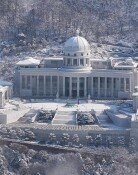S. Korean military seeks to salvage debris from N. Korea’s SRBM
S. Korean military seeks to salvage debris from N. Korea’s SRBM
Posted November. 05, 2022 07:24,
Updated November. 05, 2022 07:24
The South Korean military is conducting an operation to salvage debris from a submarine-launched ballistic missile, fired Wednesday by North Korea across the Northern Limit Line for the first time. Suppose the military succeeds in the operation by collecting key parts, including projectile and warhead. In that case, they can be important clues to identifying the specifications of Pyongyang’s SRBMs that belong new KN group.
According to the South Korean military on Friday, the Navy’s maritime salvage and rescue ship Gwangyang (3,500 tons) have been mobilized to the waters where the North’s SRBM fell and carefully examined the sites. One of the SRBM, fired from the Wonsan in Kangwon in the North, crossed the NLL about 190 kilometers before falling into waters 57 kilometers east of the port of Sokcho and 167 kilometers northwest of the Ulleung Island in the East Sea. Insiders and outsiders of the military speculate that the missile is a new KN-group SRBM.
“We are carefully and extensively searching for debris of the missile by using various search equipment including the sonar and remotely operated underwater vehicles (ROV) on the Gwangyang because the waters in the areas are quite deep,” a South Korean military official said. When the North fired long-range missiles in 2012 and 2016, the South Korean navy also deployed a maritime salvage and rescue ship and collected debris. Suppose the military succeeds in salvaging debris this time. In that case, the findings will provide a significant clue to identifying the performance and technology for the North’s new SRBM, which uses a solid fuel engine.
Additionally, the military is reportedly speculating that the three SRBMs, which the North fired from Goksan in North Hwanghae Province in a show of protest against the South Korea and U.S. allied forces’ decision to extend their joint aviation drill ‘Vigilant Storm,’ are missiles that belong to the Scud-B and C groups that use liquid fuel projectiles.
Sang-Ho Yun ysh1005@donga.com







